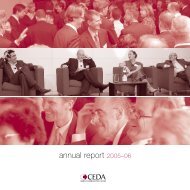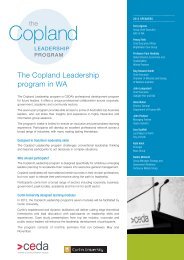A Greater Australia: Population, policies and governance - CEDA
A Greater Australia: Population, policies and governance - CEDA
A Greater Australia: Population, policies and governance - CEDA
- No tags were found...
Create successful ePaper yourself
Turn your PDF publications into a flip-book with our unique Google optimized e-Paper software.
Section 4.1In theory, the answer partly turns on whether migrants are complements to or substitutesfor local workers. At the micro level, it may seem obvious that the immigration of,say, fitters <strong>and</strong> turners must reduce the dem<strong>and</strong> for <strong>Australia</strong>n fitters <strong>and</strong> turners, <strong>and</strong>worsen their labour market outcomes (<strong>and</strong> benefit the users of their labour services).However, the reverse can occur. For example, a large project may not go ahead unlessthe supply of fitters <strong>and</strong> turners is augmented quickly, <strong>and</strong> immigration is the onlysource of those extra workers; in this instance, immigrant fitter <strong>and</strong> turner workers arecomplements to their <strong>Australia</strong>n counterparts, <strong>and</strong> not substitutes for them. Moreover,even if immigrant <strong>and</strong> <strong>Australia</strong>n fitters <strong>and</strong> turners are substitutes, <strong>and</strong> even if increasedimmigration results in lower wages for fitters <strong>and</strong> turners, the effect may be an increasein the dem<strong>and</strong> for complementary <strong>Australia</strong>n workers, say, truck drivers.These may of course be short-run effects. For example, the lifetime wage prospectsof <strong>Australia</strong>n fitters <strong>and</strong> turners may weaken if immigration frequently fills short-run <strong>and</strong>potentially damaging labour shortages. The expectation is that wages for occupationsin short supply would be bid up, which in turn would attract workers to apply forthe vacant positions <strong>and</strong>/or train to meet the requirements of the occupations experiencingshortages. However, if migrants fill vacancies – particularly through temporaryskilled visas such 457 Visas – then the price signal is blurred <strong>and</strong> the domestic supplyresponse is blunted. By truncating the increase in the relative wages of occupations inshort supply, the losses are borne by local workers who might otherwise be attractedto the jobs.Richardson has outlined various types of skill shortages <strong>and</strong> the appropriate solutionsto each. 15 She makes a distinction between occupations requiring training that takea short time <strong>and</strong> those that require lengthy training. In addition, she highlights theadequacy, or otherwise, of the pool of relevantly trained workers, some of whom maynot be working in the occupations with skill shortages. The case of inferior qualityworkers is also described.In terms of constraints on economic growth, the main concern is the case of occupationsrequiring lengthy training periods <strong>and</strong> where there are few local workers withthose skills not currently employed in the occupations. By contrast, support for highermigration on the grounds of skill shortages is generally much more broadly-based,covering Richardson’s other categories of skill shortages. The downside of a policybased on such broad advocacy, is that it potentially undermines the workings of thelabour market that would otherwise self-correct many of these skill shortages.Immigrants add to dem<strong>and</strong> generally within the economy; <strong>and</strong> maybe add more todem<strong>and</strong> than to the supply of labour. So, even if some immigrants are close substitutesfor specific types of <strong>Australia</strong>n workers, it is possible that, at the macro or nationallevels, immigrant workers <strong>and</strong> their families will raise real wages generally in <strong>Australia</strong>.Pope <strong>and</strong> Withers report this was the case for <strong>Australia</strong>, from 1861 to 1991. 16 Mostquantitative research, however, focuses on data for more recent periods, with mixedresults.For example, Harris <strong>and</strong> Robertson obtain a negative wage effect for skilled localworkers arising from the entry of skilled migrants. 17 But other <strong>Australia</strong>n studies 18have found zero or slightly positive wage effects on incumbents. In a multi-countrystudy, Docquier, Ozden <strong>and</strong> Peri find, for <strong>Australia</strong>, a negative relationship for high-skillworkers, a positive relationship for low-skill workers <strong>and</strong> a small positive effect overallon average wages of local workers. 19A query is raised by Pincus as to why the effects found by Docquier et al are so large for<strong>Australia</strong> (<strong>and</strong> Singapore), hypothesising that the mining boom may have contributedto this result. 20 The higher relative earnings of workers in mining have been associatedA <strong>Greater</strong> <strong>Australia</strong>: <strong>Population</strong>, Policies <strong>and</strong> Governance180





